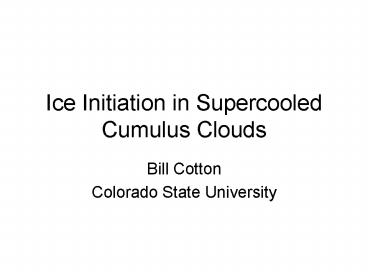Ice Initiation in Supercooled Cumulus Clouds - PowerPoint PPT Presentation
Title:
Ice Initiation in Supercooled Cumulus Clouds
Description:
Oraltay and Hallett (1989) and Dong et al. (1994) examined the generation of ... A single well-instrumented aircraft like the UWYO King Air would be perfect. ... – PowerPoint PPT presentation
Number of Views:24
Avg rating:3.0/5.0
Title: Ice Initiation in Supercooled Cumulus Clouds
1
Ice Initiation in Supercooled Cumulus Clouds
- Bill Cotton
- Colorado State University
2
Observations of high ice particle concentrations
- Rangno and Hobbs (1994, 1991) and Hobbs and
Rangno (1985) report on aircraft observations of
ice particle initiation in maritime and
continental cumulus clouds. They find that ice
particle initiation is a two-stage process.
During stage 1, initial ice particles seem to
originate through the freezing of larger cloud
droplets in concentrations com-parable to that
estimated with the formula of Meyers et al.
(1992) derived from IN measurements. During
stage 2, however, ice particle concentrations of
tens to 100's per liter form in less than ten
minutes. Such high concen-trations appear
coincident with or soon after the formation of
graupel particles. Supercooled raindrops or
drizzle drops need not be present. In some of
their cases the time-scales of high ice particle
concentration formation is too short for the
rime-splinter process to account for the
observations. In other cases it might explain
the observa-tions. We conclude that there still
remain mysteries about ice formation in some
clouds.
3
Ice generation during evaporation of ice
particles
- Oraltay and Hallett (1989) and Dong et al. (1994)
examined the generation of secondary particles
during the evaporation of ice particles. At
relative humidities below 70, as many as 30
pieces per crystal formed. This did not occur
with columns or solid plates. Evaporation of
simulated graupel particles of a few millimeters
produced several hundred ice particles under
certain conditions. This process has not been
further quantified in the laboratory or been
inserted in cloud models to examine its potential
importance. Circumstantially this process fits
with numerous observations which suggest
enhancements of ice crystal concentrations during
evaporation of clouds or in heavily mixed
regions. What needs to be determined is will
these evaporated bits" survive long enough
during entrainment events to serve as embryos for
further ice crystal growth?
4
Proposed Observations in cumuli
- First attempt to replicate Hobbs and Rangno
observations - A single well-instrumented aircraft like the UWYO
King Air would be perfect. - It should have LWC, PMS probes, CPI, CCN,
GCCN(ideal), and IN(CFDC), WCR would be nice too
but I know that it will not fit with above. - Soundings(T, RH, winds, CCN, GCCN, IN) before and
after cloud penetrations - Obtain multiple penetrations at temperatures
around -10C and colder to define lifecycle of ice
evolution - The study should follow a case study approach to
enable modelers to determine if current theories
can account for rapid ice formation
5
Locations
- Begin in State of Washington east and west of
Cascades in locations and time of year similar to
Hobbs and Rangno to see if their observations can
be replicated - Do the same say in NE Colorado
- Do the same in central Texas
6
Summary
- The proposed observations should provide a good
cross section of how ice in supercooled cumuli
evolves in different airmasses and provide case
studies that can be used for numerical
simulations.































